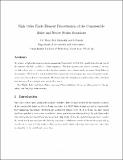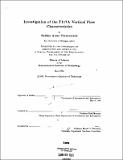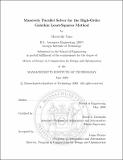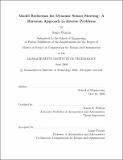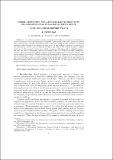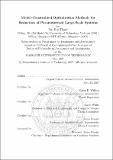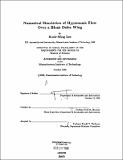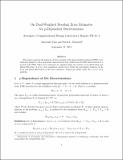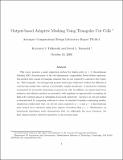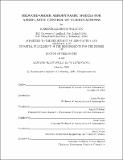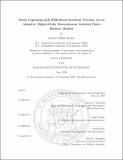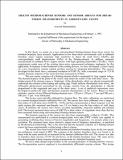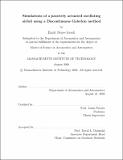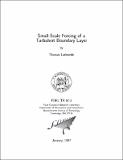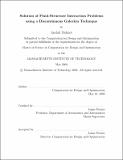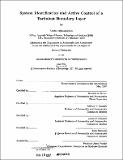Browsing Aerospace Computational Design Laboratory by Title
Now showing items 12-31 of 33
-
High Order Finite Element Discretization of the Compressible Euler and Navier-Stokes Equations
(Aerospace Computational Design Laboratory, Dept. of Aeronautics & Astronautics, Massachusetts Institute of Technology, 2001-04)We present a high order accurate streamline-upwind/Petrov-Galerkin (SUPG) algorithm for the solution of the compressible Euler and Navier-Stokes equations. The flow equations are written in terms of entropy variables which ... -
Integral methods for three-dimensional boundary layers
(Aerospace Computational Design Laboratory, Dept. of Aeronautics & Astronautics, Massachusetts Institute of Technology, 1998-02)Several distinct issues important in integral approximations of the three-dimensional boundary-layer equations are addressed. One of these is the requirement, justified on the basis of the nature of the full differential ... -
Investigation of the F117A Vortical Flow Characteristics Preliminary Results
(Aerospace Computational Design Lab, Dept. of Aeronautics & Astronautics, Massachusetts Institute of Technology, 1992-10)The investigation of the vortical flow around the F117A Stealth Fighter is presented in order to demonstrate the capability to resolve leading edge vortices with an adaptive finite element solver for the Euler equations. ... -
Massively Parallel Solver for the High-Order Galerkin Least-Squares Method
(Aerospace Computational Design Laboratory, Dept. of Aeronautics & Astronautics, Massachusetts Institute of Technology, 2009-06)A high-order Galerkin Least-Squares (GLS) finite element discretization is combined with massively parallel implicit solvers. The stabilization parameter of the GLS discretization is modified to improve the resolution ... -
Measurement of the Mass Flow and Tangential Momentum Accommodation Coefficient in Silicon Micromachined Channels
(Aerospace Computational Design Laboratory, Dept. of Aeronautics & Astronautics, Massachusetts Institute of Technology, 1997-01)An analytic and experimental investigation into gaseous flow with slight rarefaction through long microchannels is undertaken in an attempt to obtain values of the Tangential Momentum Accommodation Coefficient (TMAC) ... -
Model Reduction for Dynamic Sensor Steering: A Bayesian Approach to Inverse Problems
(Aerospace Computational Design Laboratory, Dept. of Aeronautics & Astronautics, Massachusetts Institute of Technology, 2008-06)In many settings, distributed sensors provide dynamic measurements over a specified time horizon that can be used to reconstruct information such as parameters, states or initial conditions. This estimation task can be ... -
Model Reduction for Large-Scale Systems with High Dimensional Parametric Input Space
(Aerospace Computational Design Laboratory, Dept. of Aeronautics & Astronautics, Massachusetts Institute of Technology, 2007-08)A model-constrained adaptive sampling methodology is proposed for reduction of large-scale systems with high-dimensional parametric input spaces. Our model reduction method uses a reduced basis approach, which requires the ... -
Model-Constrained Optimization Methods for Reduction of Parameterized Large-Scale Systems
(Aerospace Computational Design Laboratory, Dept. of Aeronautics & Astronautics, Massachusetts Institute of Technology, 2007-05)Most model reduction techniques employ a projection framework that utilizes a reduced-space basis. The basis is usually formed as the span of a set of solutions of the large-scale system, which are computed for selected ... -
Numerical Simulation of Hypersonic Flow Over a Blunt Leading Edge Delta Wing
(Aerospace Computational Design Lab, Dept. of Aeronautics & Astronautics, Massachusetts Institute of Technology, 1989-10)Euler and Navier-Stokes results are presented for a blunt delta wing at Mach 7.15 and 300 angle of attack. The viscous calculations were done at a Reynolds number based on chord of 5.85 x 106 with freestream and wall ... -
On Dual-Weighted Residual Error Estimates for p-Dependent Discretizations
(Aerospace Computational Design Laboratory, Dept. of Aeronautics & Astronautics, Massachusetts Institute of Technology, 2011-09-21)This report analyzes the behavior of three variants of the dual-weighted residual (DWR) error estimates applied to the p-dependent discretization that results from the BR2 discretization of a second-order PDE. Three error ... -
Output-based Adaptive Meshing Using Triangular Cut Cells
(Aerospace Computational Design Laboratory, Dept. of Aeronautics & Astronautics, Massachusetts Institute of Technology, 2006-10)This report presents a mesh adaptation method for higher-order (p > 1) discontinuous Galerkin (DG) discretizations of the two-dimensional, compressible Navier-Stokes equations. The method uses a mesh of triangular elements ... -
A Posteriori Bounds for Linear Functional Outputs of Hyperbolic Partial Differential Equations
(Aerospace Computational Design Laboratory, Dept. of Aeronautics & Astronautics, Massachusetts Institute of Technology, 1997-02)One of the major difficulties faced in the numerical resolution of the equations of physics is to decide on the right balance between computational cost and solutions accuracy, and to determine how solutions errors affect ... -
Reduced-order aerodynamic models for aeroelastic control of turbomachines
(Aerospace Computational Design Laboratory, Dept. of Aeronautics & Astronautics, Massachusetts Institute of Technology, 2000-02)Aeroelasticity is a critical consideration in the design of gas turbine engines, both for stability and forced response. Current aeroelastic models cannot provide high-fidelity aerodynamics in a form suitable for design ... -
A Semi-Implicit Navier-Stokes Solver and Its Application to a Study of Separated Flow about Blunt Delta Wings
(Aerospace Computational Design Lab, Dept. of Aeronautics & Astronautics, Massachusetts Institute of Technology, 1989-02)A novel semi-implicit scheme for the Navier-Stokes equations is presented and evaluated. The semi-implicit scheme combines an implicit temporal integration in the bodynormal directions with explicit temporal integrations ... -
Shock Capturing with PDE-Based Artificial Viscosity for an Adaptive, Higher-Order Discontinuous Galerkin Finite Element Method
(Aerospace Computational Design Laboratory, Dept. of Aeronautics & Astronautics, Massachusetts Institute of Technology, 2008-06)The accurate simulation of supersonic and hypersonic flows is well suited to higher-order (p > 1), adaptive computational fluid dynamics (CFD). Since these cases involve flow velocities greater than the speed of sound, an ... -
Silicon micromachined sensors and sensor arrays for shear-stress measurements in aerodynamic flows
(Aerospace Computational Design Laboratory, Dept. of Aeronautics & Astronautics, Massachusetts Institute of Technology, 1997-02)In this thesis we report on a new micromachined floating-element shear-stress sensor for turbulent boundary layer research. Applications in low shear-stress environments such as turbulent boundary layers require extremely ... -
Simulations of a passively actuated oscillating airfoil using a Discontinuous Galerkin method
(Aerospace Computational Design Laboratory, Dept. of Aeronautics & Astronautics, Massachusetts Institute of Technology, 2008-08)Natural flappers, such as birds and bats, effectively maneuver in transitional, low Reynolds number flow, outperforming any current small engineered flapping vehicle. Thus, engineers are inspired to investigate the flapping ... -
Small-Scale Forcing of a Turbulent Boundary Layer
(Aerospace Computational Design Laboratory, Dept. of Aeronautics & Astronautics, Massachusetts Institute of Technology, 1997-01)In order to understand the effect of small scale forcing on turbulent flows and its implications on control, an experimental investigation is made into the forcing of the inertial scales in the wall region of a turbulent ... -
Solution of Fluid-Structure Interaction Problems using a Discontinuous Galerkin Technique
(Aerospace Computational Design Laboratory, Dept. of Aeronautics & Astronautics, Massachusetts Institute of Technology, 2008-05)The present work aims to address the problem of fluid-structure interaction using a discontinuous Galerkin approach. Starting from the Navier-Stokes equations on a fixed domain, an arbitrary Lagrangian Eulerian (ALE) ... -
System Identification and Active Control of a Turbulent Boundary Layer
(Aerospace Computational Design Lab, Dept. of Aeronautics & Astronautics, Massachusetts Institute of Technology, 1997-06)An experimental investigation is made into the active control of the near-wall region of a turbulent boundary layer using a linear control scheme. System identification in the boundary layer provides optimal transfer ...

